Synergistically Enhanced Electrochemical Sensing of Food Adulterant in Milk Sample at Erbium Vanadate/Graphitic Carbon Nitride Composite
Abstract
1. Introduction
2. Experimental Section
2.1. Materials and Reagents
2.2. Intruments
2.3. Synthesis of ErVO4
2.4. Synthesis of Graphitic Carbon Nitride (g-CN)
2.5. Preparation of ErVO4@g-CN-Modified GCE
3. Results and Discussion
3.1. Characterization of ErVO4@g-CN
3.2. Electrochemical Analysis in [Fe (CN)6]3−/4− Solution
3.3. Electrochemical Analysis
3.3.1. Electrochemical Behaviors toward DMZ Detection
3.3.2. Effect of pH
3.3.3. Effect of Concentration and Scan Rate
3.3.4. Differential Pulse Voltammetry (DPV) Study for Determination of DMZ and Real Sample Analysis
3.3.5. Selectivity, Reproducibility, Repeatability and Stability
4. Conclusions
Supplementary Materials
Author Contributions
Funding
Institutional Review Board Statement
Informed Consent Statement
Data Availability Statement
Acknowledgments
Conflicts of Interest
References
- Connolly, L.; Thompson, C.S.; Haughey, S.A.; Traynor, I.M.; Tittlemeier, S.; Elliott, C.T. The development of a multi-nitroimidazole residue analysis assay by optical biosensor via a proof of concept project to develop and assess a prototype test kit. Anal. Chim. Acta 2007, 598, 155–161. [Google Scholar] [CrossRef] [PubMed]
- Hu, C.; Deng, J.; Xiao, X.; Zhan, X.; Huang, K.; Xiao, N.; Ju, S. Determination of dimetridazole using carbon paste electrode modified with aluminum doped surface molecularly imprinted siloxane. Electrochim. Acta 2015, 158, 298–305. [Google Scholar] [CrossRef]
- Available online: https://www.obrnutafaza.hr/pdf/uct/aplikacije/Veterinary.pdf (accessed on 26 February 2024).
- Quinlivan, P.J.; Upmacis, R.K. Crystal structure of di-μ-chlorido-bis [chloridobis (1, 2-dimethyl-5-nitro-1H-imidazole-κN3) copper (II)] acetonitrile disolvate. Acta Crystallogr. Sect. E Crystallogr. Commun. 2016, 72, 1633–1636. [Google Scholar] [CrossRef] [PubMed]
- Zoubir, J.; Elkhotfi, Y.; Radaa, C.; Bougdour, N.; Idlahcen, A.; Bakas, I.; Assabbane, A. Electrocatalytic detection of dimetridazole using an electrochemical sensor Ag@ CPE. Analytical application. Milk, tomato juice and human urine. Sens. Int. 2021, 2, 100105. [Google Scholar] [CrossRef]
- Granja, R.H.; Nino, A.M.; Reche, K.V.; Giannotti, F.M.; de Lima, A.C.; Wanschel, A.C.; Salerno, A.G. Determination and confirmation of metronidazole, dimetridazole, ronidazole and their metabolites in bovine muscle by LC-MS/MS. Food Addit. Contam. Part A 2013, 30, 970–976. [Google Scholar] [CrossRef]
- Lin, Y.; Su, Y.; Liao, X.; Yang, N.; Yang, X.; Choi, M.M. Determination of five nitroimidazole residues in artificial porcine muscle tissue samples by capillary electrophoresis. Talanta 2012, 88, 646–652. [Google Scholar] [CrossRef]
- Guth, U.; Vonau, W.; Zosel, J. Recent developments in electrochemical sensor application and technology—A review. Meas. Sci. Technol. 2009, 20, 042002. [Google Scholar] [CrossRef]
- Tian, J.; Xu, J.; Zhu, F.; Lu, T.; Su, C.; Ouyang, G. Application of nanomaterials in sample preparation. J. Chromatogr. A 2013, 1300, 2–16. [Google Scholar] [CrossRef]
- Oka, Y.; Yao, T.; Yamamoto, N. Hydrothermal synthesis of lanthanum vanadates: Synthesis and crystal structures of zircon-type LaVO4 and a new compound LaV3O9. J. Solid State Chem. 2000, 152, 486–491. [Google Scholar] [CrossRef]
- Polman, A. Erbium as a probe of everything? Phys. B Condens. Matter 2001, 300, 78–90. [Google Scholar] [CrossRef]
- Cortese, A.J.; Smith, M.D.; Zur Loye, H.C. Crystal growth, structure, and properties, of a new oxovanadium (IV) phosphate material, [H2en]4 [V7P8O35 (OH)6 (H2O)]· 3H2O prepared via a mild one step hydrothermal route. Solid State Sci. 2016, 60, 59–64. [Google Scholar] [CrossRef]
- Liu, X.; He, J.-H.; Sakthivel, R.; Chung, R.-J. Rare earth erbium molybdate nanoflakes decorated functionalized carbon nanofibers: An affordable and potential catalytic platform for the electrooxidation of phenothiazine. Electrochim. Acta 2020, 358, 136885. [Google Scholar] [CrossRef]
- Selvan, R.K.; Gedanken, A.; Anilkumar, P.; Manikandan, G.; Karunakaran, C. Synthesis and characterization of rare earth orthovanadate (RVO4; R = La, Ce, Nd, Sm, Eu & Gd) nanorods/nanocrystals/Nanospindles by a facile sonochemical method and their catalytic properties. J. Clust. Sci. 2008, 20, 291–305. [Google Scholar] [CrossRef]
- Devaraju, M.K.; Honma, I. Hydrothermal and solvothermal process towards development of LiMPO4 (M= Fe, Mn) nanomaterials for lithium-ion batteries. Adv. Energy Mater. 2012, 2, 284–297. [Google Scholar] [CrossRef]
- Gan, Y.X.; Jayatissa, A.H.; Yu, Z.; Chen, X.; Li, M. Hydrothermal synthesis of nanomaterials. J. Nanomater. 2020, 2020, 8917013. [Google Scholar] [CrossRef]
- Kogularasu, S.; Lee, Y.Y.; Sriram, B.; Wang, S.F.; George, M.; Chang-Chien, G.P.; Sheu, J.K. Unlocking Catalytic Potential: Exploring the Impact of Thermal Treatment on Enhanced Electrocatalysis of Nanomaterials. Angew. Chem. 2023, 136, e202311806. [Google Scholar] [CrossRef]
- Huang, X.; Zhang, G.; Dong, F.; Tang, Z. The remarkable promotional effect of Sn on CeVO4 catalyst for wide temperature NH3-SCR process by citric acid-assisted solvothermal synthesis and post-hydrothermal treatment. Catal. Sci. Technol. 2018, 8, 5604–5615. [Google Scholar] [CrossRef]
- Kesavan, G.; Vinothkumar, V.; Chen, S.-M.; Thangadurai, T.D. Construction of metal-free oxygen-doped graphitic carbon nitride as an electrochemical sensing platform for determination of antimicrobial drug metronidazole. Appl. Surf. Sci. 2021, 556, 149814. [Google Scholar] [CrossRef]
- Sharma, T.S.K.; Ganguly, A.; Santhan, A.; Hwa, K.-Y. Gadolinium oxide nanorods anchored on g-C3N4 nanosheets for dual-mode electrochemical determination of clioquinol in real-time analysis. ACS Appl. Nano Mater. 2022, 5, 5208–5222. [Google Scholar] [CrossRef]
- Bharathi, P.; Wang, S.-F. Synchronous activation of praseodymium vanadate/graphitic carbon nitride nanocomposite: A promising electrode material for detection of flavonoid–Quercetin. Food Chem. 2024, 441, 138405. [Google Scholar] [CrossRef]
- Kokulnathan, T.; Chen, S.-M. Praseodymium vanadate-decorated sulfur-doped carbon nitride hybrid nanocomposite: The role of a synergistic electrocatalyst for the detection of metronidazole. ACS Appl. Mater. Interfaces 2019, 11, 7893–7905. [Google Scholar] [CrossRef] [PubMed]
- Vinoth, S.; Wang, S.-F. Modification of glassy carbon electrode with manganese cobalt oxide-cubic like structures incorporated graphitic carbon nitride sheets for the voltammetric determination of 2,4,6-trichlorophenol. Microchim. Acta 2022, 189, 205. [Google Scholar] [CrossRef] [PubMed]
- Tseng, T.-W.; Chen, T.-W.; Chen, S.-M.; Kokulnathan, T.; Ahmed, F.; Hasan, P.; Bilgrami, A.L.; Kumar, S. Construction of strontium phosphate/graphitic-carbon nitride: A flexible and disposable strip for acetaminophen detection. J. Hazard. Mater. 2020, 410, 124542. [Google Scholar] [CrossRef]
- Alkorbi, A.S.; Kumar, K.Y.; Prashanth, M.; Parashuram, L.; Abate, A.; Alharti, F.A.; Jeon, B.-H.; Raghu, M. Samarium vanadate affixed sulfur self doped g-C3N4 heterojunction; photocatalytic, photoelectrocatalytic hydrogen evolution and dye degradation. Int. J. Hydrogen Energy 2022, 47, 12988–13003. [Google Scholar] [CrossRef]
- Sha, H.; Zhang, Y.; Wang, Y.; Ke, H.; Xiong, X.; Jia, N. Electrochemiluminescence resonance energy transfer biosensor between the glucose functionalized MnO2 and g-C3N4 nanocomposites for ultrasensitive detection of concanavalin A. Biosens. Bioelec-Tron. 2019, 124, 59–65. [Google Scholar] [CrossRef]
- Kokulnathan, T.; Wang, T.-J.; Kumar, E.A.; Duraisamy, N.; Lee, A.-T. An electrochemical platform based on yttrium oxide/boron nitride nanocomposite for the detection of dopamine. Sens. Actuators B Chem. 2021, 349, 130787. [Google Scholar] [CrossRef]
- Koventhan, C.; Vinothkumar, V.; Chen, S.-M. Development of an electrochemical sensor based on a cobalt oxide/tin oxide composite for determination of antibiotic drug ornidazole. N. J. Chem. 2021, 45, 12593–12605. [Google Scholar] [CrossRef]
- Sharma, T.S.K.; Jana, J.; Bhamu, K.; Song, J.; Sivaselvam, S.; Van Tam, T.; Kang, S.G.; Chung, J.S.; Hur, S.H.; Choi, W.M. Rational synthesis of alkaline earth metal vanadates: Structural origin of MgVO3 honeycomb lattice system and its electrochemical analysis for the detection of sulfadiazine. Chem. Eng. J. 2023, 464, 142673. [Google Scholar] [CrossRef]
- Priscillal, I.J.D.; Wang, S.-F. Fergusonite-type rare earth niobates ANbO4 (A = Nd, Sm, and Eu) as electrode modifiers: Deep insights into A site variations towards bifunctional electrochemical sensing applications. Nanoscale 2023, 15, 8693–8705. [Google Scholar] [CrossRef]
- Sharma, T.S.K.; Hwa, K.Y. Architecting hierarchal Zn3V2O8/P-rGO nanostructure: Electrochemical determination of anti-viral drug azithromycin in biological samples using SPCE. Chem. Eng. J. 2022, 439, 135591. [Google Scholar] [CrossRef]
- Rajaji, U.; Selvi, S.V.; Chen, S.M.; Chinnapaiyan, S.; Chen, T.W.; Govindasamy, M. A nanocomposite consisting of cuprous oxide supported on graphitic carbon nitride nanosheets for non-enzymatic electrochemical sensing of 8-hydroxy-2′-deoxyguanosine. Microchim. Acta 2020, 187, 459. [Google Scholar] [CrossRef] [PubMed]
- Sriram, B.; Baby, J.N.; Hsu, Y.-F.; Wang, S.-F.; Joseph, X.B.; George, M.; Veerakumar, P.; Lin, K.C. MnCo2O4 Microflowers Anchored on P-Doped g-C3N4 Nanosheets as an Electrocatalyst for Voltammetric Determination of the Antibiotic Drug Sulfadiazine. ACS Appl. Electron. Mater. 2021, 3, 3915–3926. [Google Scholar] [CrossRef]
- Khoobi, A.; Shahdost-fard, F.; Arbabi, M.; Akbari, M.; Mirzaei, H.; Nejati, M.; Lotfinia, M.; Sobhani-Nasab, A.; Banafshe, H.R. Sonochemical synthesis of ErVO4/MnWO4 heterostructures: Application as a novel nanostructured surface for electrochemical determination of tyrosine in biological samples. Polyhedron 2020, 177, 114302. [Google Scholar] [CrossRef]
- Wu, L.; Dai, P.; Wen, D. New structural design strategy: Optical center VO4-activated broadband yellow phosphate phosphors for high-color-rendering WLEDs. ACS Sustain. Chem. Eng. 2022, 10, 3757–3765. [Google Scholar] [CrossRef]
- Kogularasu, S.; Sriram, B.; Wang, S.-F.; Sheu, J.-K. Sea-urchin-like Bi2S3 microstructures decorated with graphitic carbon nitride nanosheets for use in food preservation. ACS Appl. Nano Mater. 2022, 5, 2375–2384. [Google Scholar] [CrossRef]
- She, X.; Xu, H.; Xu, Y.; Yan, J.; Xia, J.; Xu, L.; Song, Y.; Jiang, Y.; Zhang, Q.; Li, H. Exfoliated graphene-like carbon nitride in organic solvents: Enhanced photocatalytic activity and highly selective and sensitive sensor for the detection of trace amounts of Cu2+. J. Mater. Chem. A 2013, 2, 2563–2570. [Google Scholar] [CrossRef]
- Alagarsamy, S.; Mariappan, K.; Chen, S.-M.; Sakthinathan, S. Hexagonally close-packed three-dimensional nano-flower entrapped on a heteroatom doped carbon sheets: A sensitive electro-catalyst to determine sulfonamide in environmental samples. Food Chem. 2023, 429, 136826. [Google Scholar] [CrossRef] [PubMed]
- Sharma, K.; Kumar, A.; Sharma, S.; Tripathi, C.S.P.; Guin, D. Covalent functionalization of graphene oxide with l-lysine for highly sensitive and selective simultaneous electrochemical detection of rifampicin and acetaminophen. J. Appl. Electrochem. 2023, 1–17. [Google Scholar] [CrossRef]
- Sriram, B.; Baby, J.N.; Wang, S.-F.; George, M.; Joseph, X.B.; Tsai, J.-T. Surface engineering of three-dimensional-like hybrid AB2O4 (AB = Zn, Co, and Mn) wrapped on sulfur-doped reduced graphene oxide: Investigation of the role of an Electrocatalyst for Clioquinol detection. ACS Appl. Electron. Mater. 2020, 3, 362–372. [Google Scholar] [CrossRef]
- Anupriya, J.; Karuppusamy, N.; Chen, S.-M.; Lin, K.-Y. Synergistically improved electrochemical performance by the assembly of nanosized praseodymium tungstate on reduced graphene oxide for the detection of dimetridazole in biological and aquatic samples. J. Environ. Chem. Eng. 2022, 10, 108800. [Google Scholar] [CrossRef]
- Mufeeda, M.; Vaishag, P.V.; Ankitha, M.; Rasheed, P.A. Unveiling the capability of graphitic carbon nitride- rhenium disulfide nanocomposite as an electrochemical sensing platform for the detection of dimetridazole from human serum samples. Mater. Adv. 2023, 4, 4159–4167. [Google Scholar] [CrossRef]
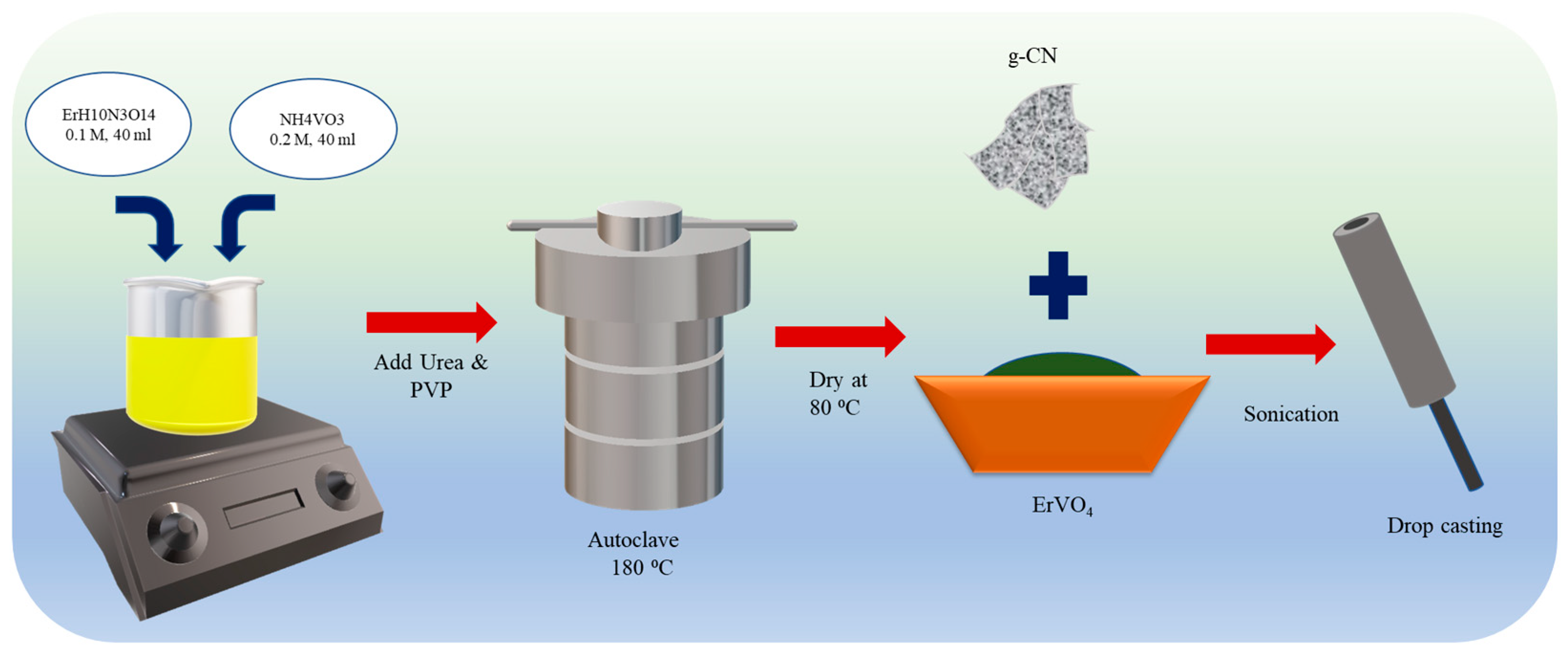
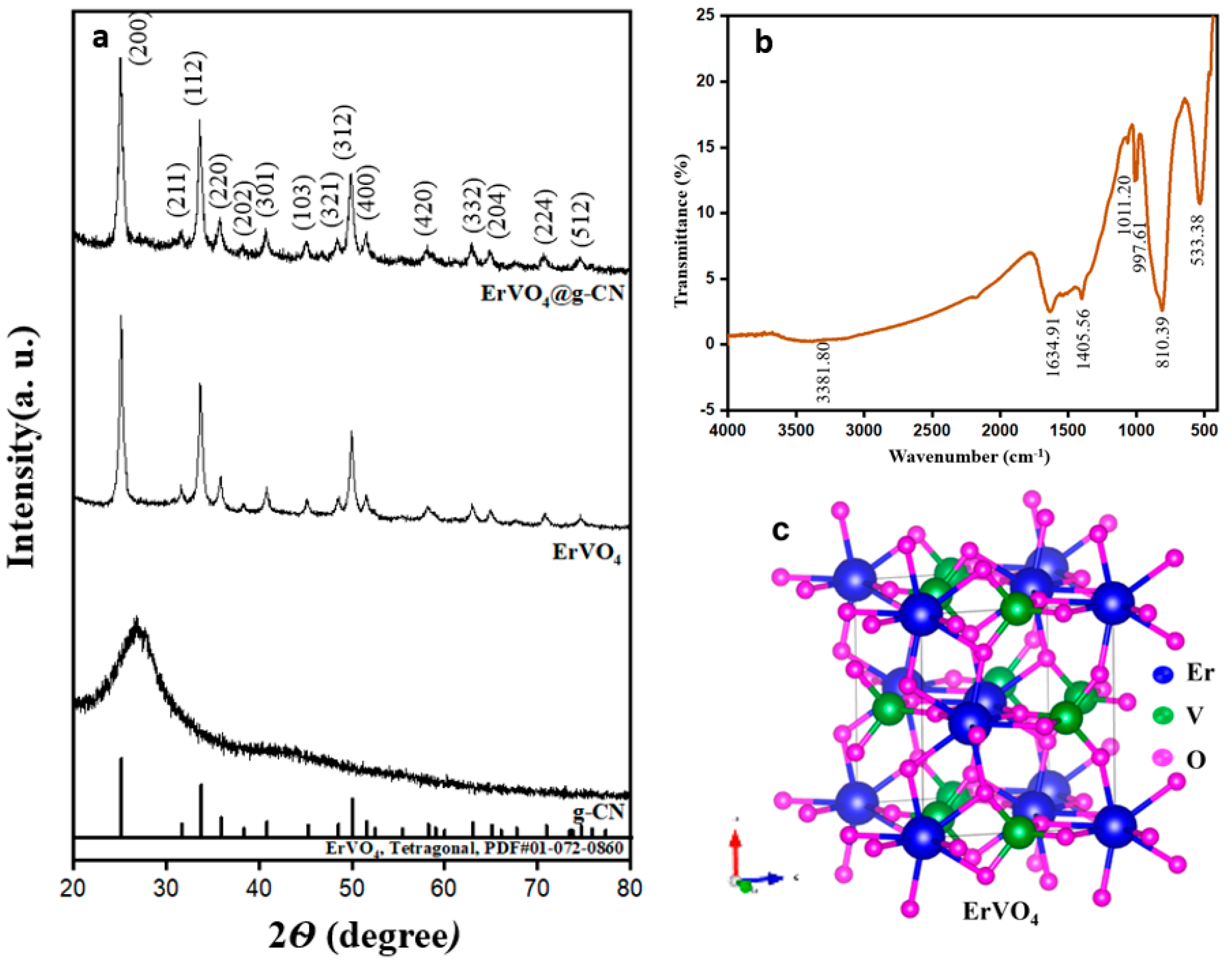
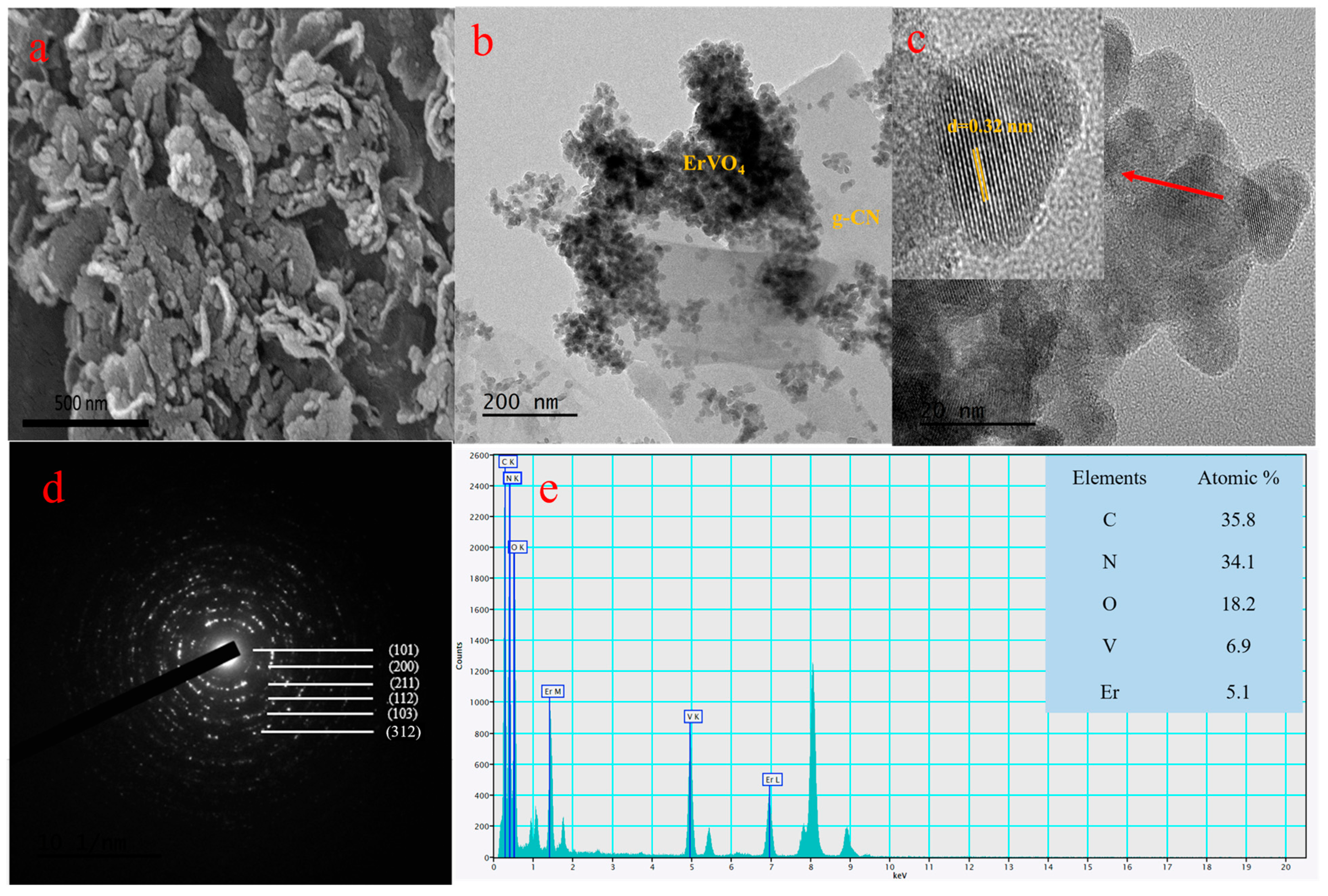

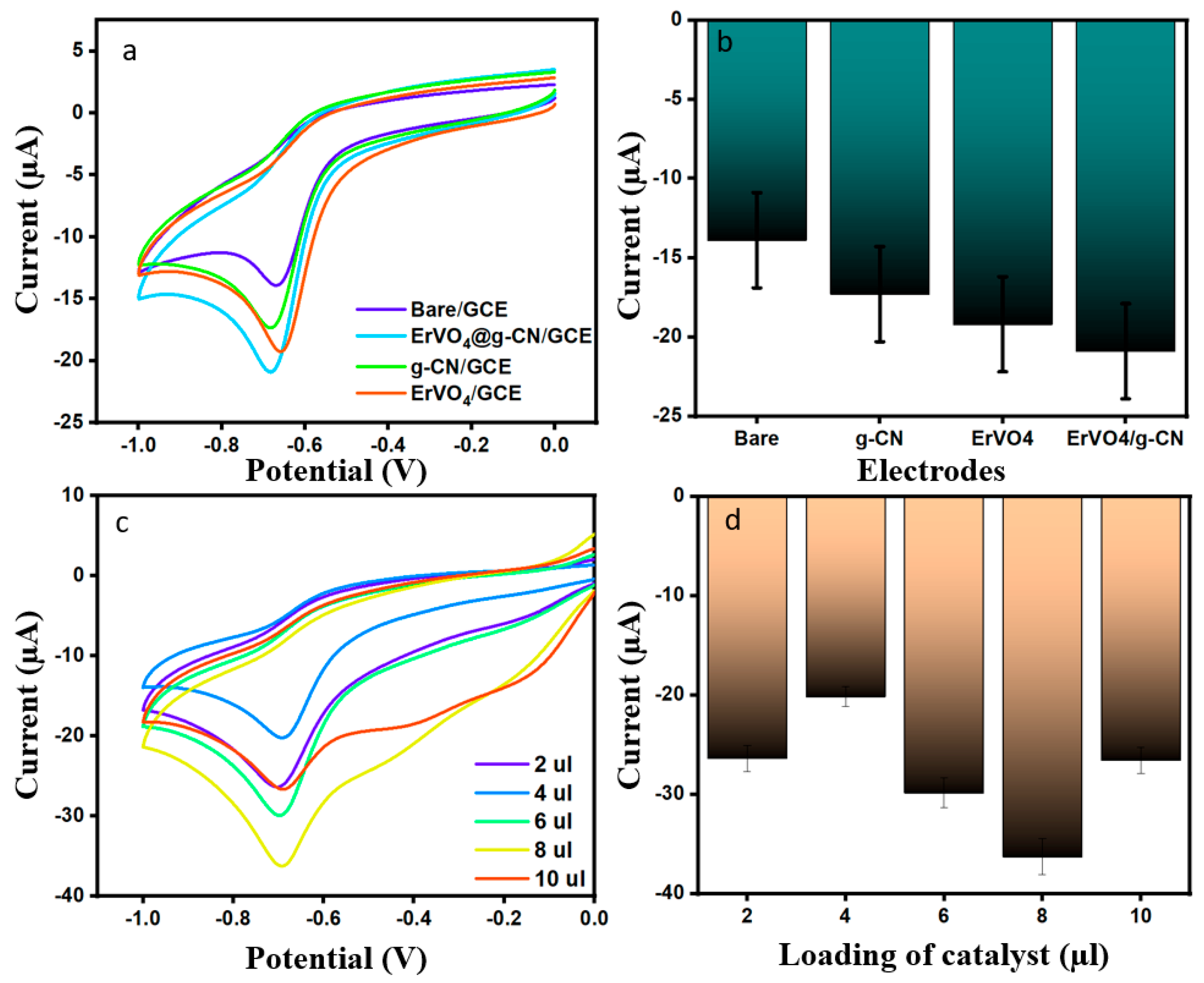

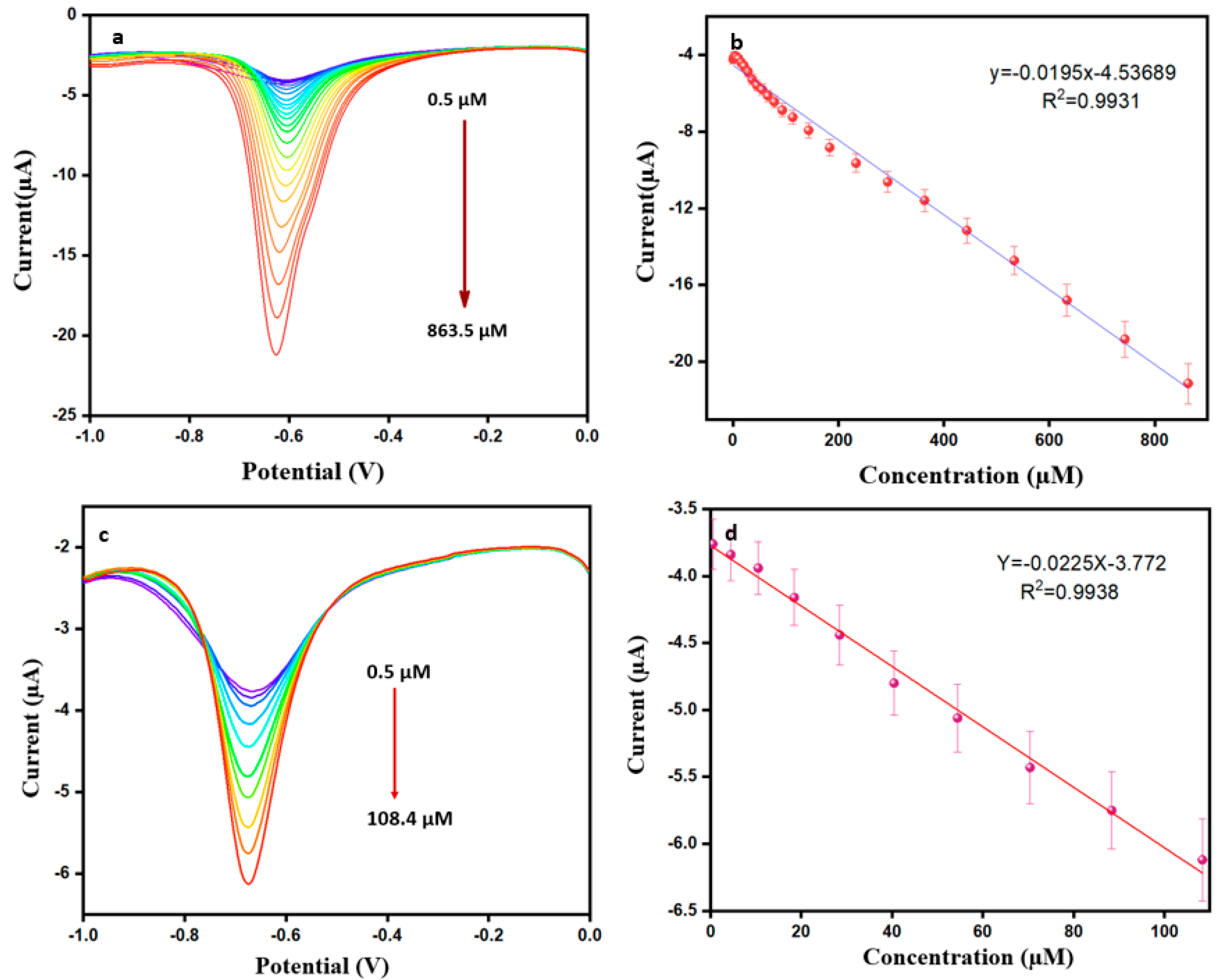


Disclaimer/Publisher’s Note: The statements, opinions and data contained in all publications are solely those of the individual author(s) and contributor(s) and not of MDPI and/or the editor(s). MDPI and/or the editor(s) disclaim responsibility for any injury to people or property resulting from any ideas, methods, instructions or products referred to in the content. |
© 2024 by the authors. Licensee MDPI, Basel, Switzerland. This article is an open access article distributed under the terms and conditions of the Creative Commons Attribution (CC BY) license (https://creativecommons.org/licenses/by/4.0/).
Share and Cite
Sanjeewani, U.G.A.; Wang, S.-F. Synergistically Enhanced Electrochemical Sensing of Food Adulterant in Milk Sample at Erbium Vanadate/Graphitic Carbon Nitride Composite. Sensors 2024, 24, 1808. https://doi.org/10.3390/s24061808
Sanjeewani UGA, Wang S-F. Synergistically Enhanced Electrochemical Sensing of Food Adulterant in Milk Sample at Erbium Vanadate/Graphitic Carbon Nitride Composite. Sensors. 2024; 24(6):1808. https://doi.org/10.3390/s24061808
Chicago/Turabian StyleSanjeewani, U. G. Anushka, and Sea-Fue Wang. 2024. "Synergistically Enhanced Electrochemical Sensing of Food Adulterant in Milk Sample at Erbium Vanadate/Graphitic Carbon Nitride Composite" Sensors 24, no. 6: 1808. https://doi.org/10.3390/s24061808
APA StyleSanjeewani, U. G. A., & Wang, S.-F. (2024). Synergistically Enhanced Electrochemical Sensing of Food Adulterant in Milk Sample at Erbium Vanadate/Graphitic Carbon Nitride Composite. Sensors, 24(6), 1808. https://doi.org/10.3390/s24061808



